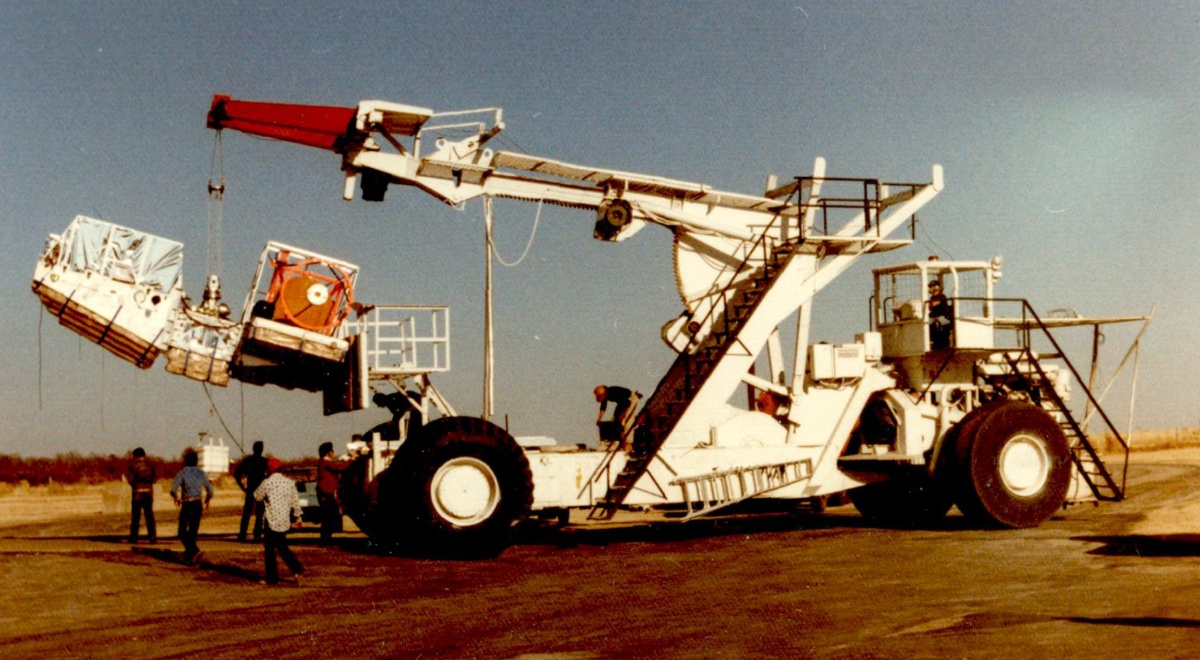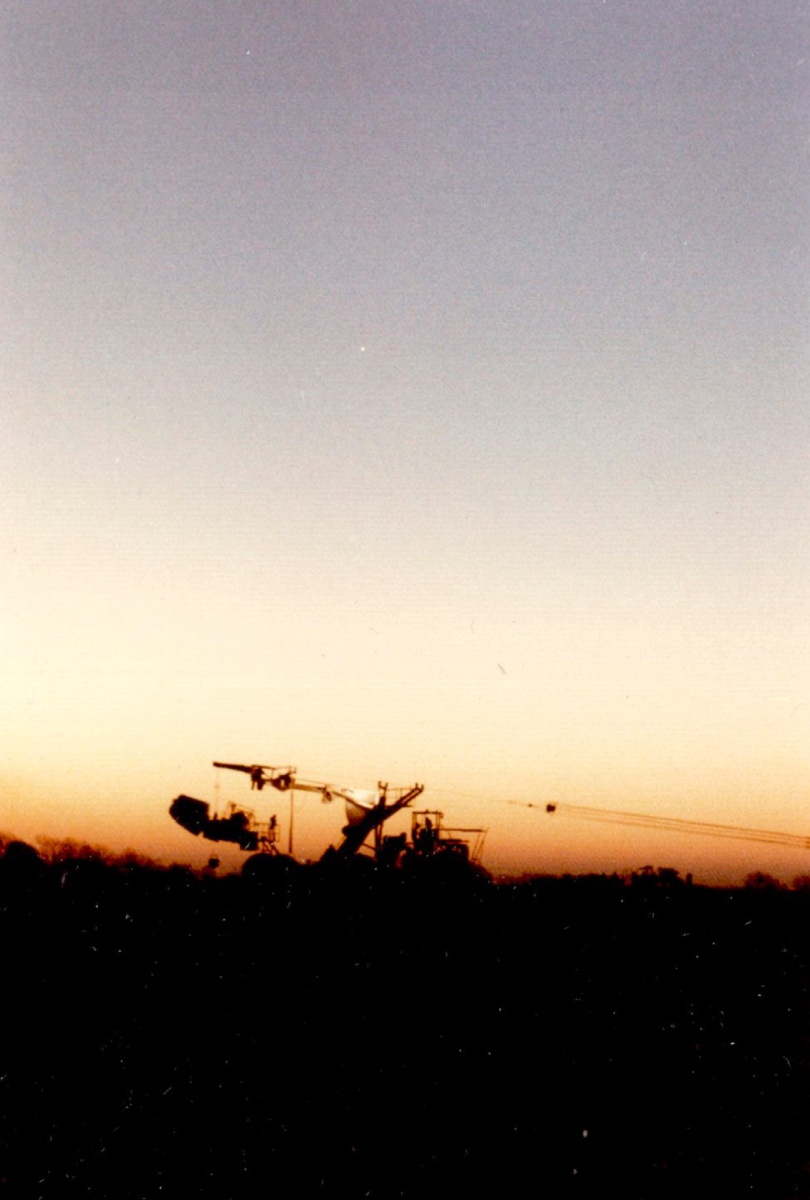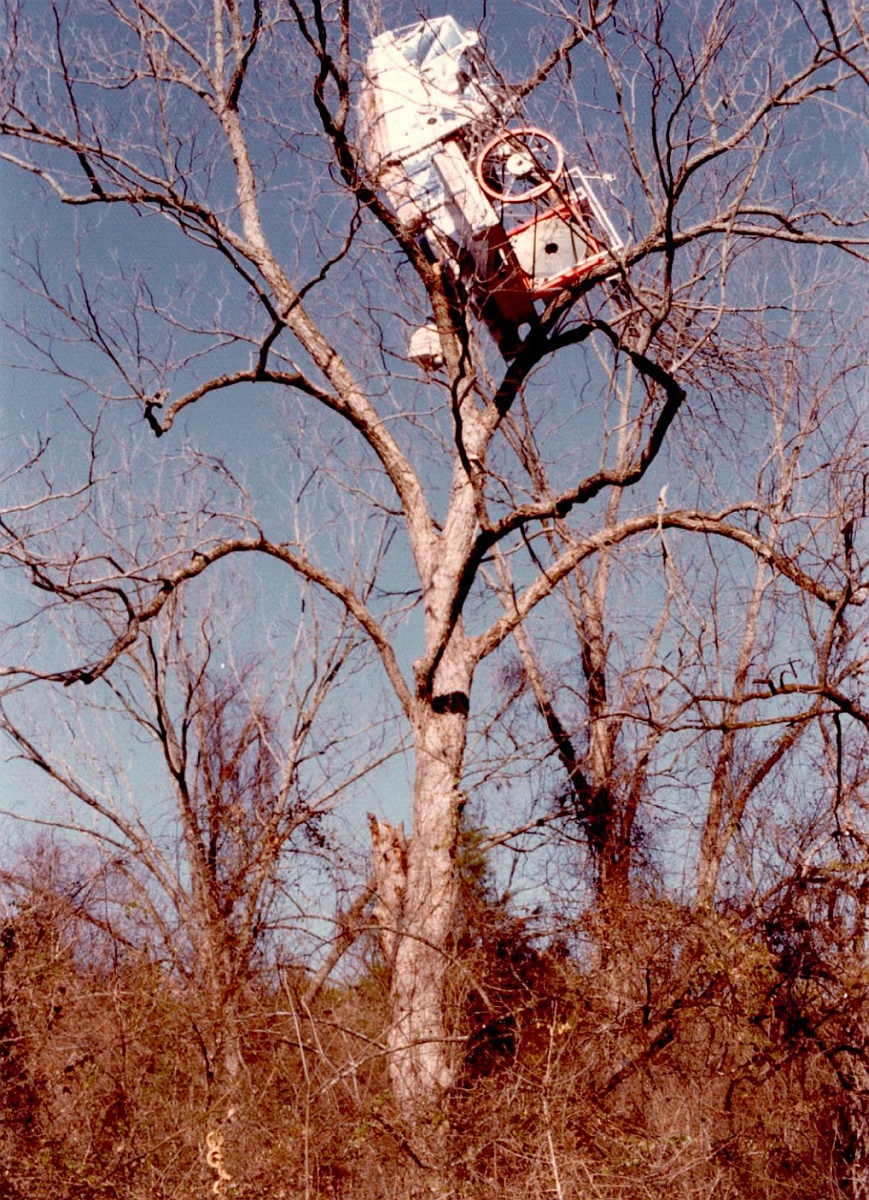Purpose of the flight and payload description
The Imperial College 41-inch telescope was a Cassegrain instrument designed for far-infrared astronomical observations. The instrument was developed during the 1970's decade by the Astronomy Group at the Blackett Laboratory, Imperial College London.
At left we can see a description of the instrument (click to enlarge). The primary mirror had a diameter of 41 inches with a spherical shape and a focal ratio of f/2.9, while the secondary mirror, also spherical, measured 13.6 inches in diameter. A flat tertiary mirror redirected the light beam at a 90° angle towards the detectors. All mirrors were crafted from aluminum alloy, gold-coated for optimal reflectivity, and tested to ensure a surface accuracy better than 4 micrometers. The primary mirror underwent traditional polishing techniques after a hard nickel layer was deposited.
The telescope was constructed entirely from aluminum alloy to ensure a negligible thermal focal shift, a crucial feature given the temperature variations during balloon flights. This design choice eliminated the need for an active focusing mechanism, simplifying operations and reducing weight. The structure incorporated Serrurier trusses, with shock-mounted supports for the 105-kg primary mirror to prevent displacement under varying attitudes. The entire system weighed 215 kg, including optics, and was kinematically mounted for stability during flight.
The system's design minimized thermal emission interference, with the secondary mirror acting as the entrance pupil and ensuring that the detector field did not extend beyond the primary mirror's edges. The aluminum optics were highly resistant to impact damage and thermal gradients, further enhancing durability and performance.
The telescope employed two helium-cooled composite bolometers for detection, allowing simultaneous two-color photometry in the 40-80 micrometer and 80-400 micrometer ranges. Each bolometer operated at a cryogenic temperature of 1.7 K, with a cold stop precisely aligned at the focal plane to restrict the field of view to 3 arcminutes. Helium-cooled filters provided wavelength selectivity, incorporating materials such as KRS-5 and diamond-dusted layers for effective spectral filtering. The detectors and filters were housed within a liquid-helium-cooled copper shield to reduce thermal noise.
A resonant focal plane chopper system facilitated rapid switching between source and background observations, minimizing microphonic noise and ensuring stability. The system used paired mirror carriages on parallel springs, driven electromagnetically with internal momentum conservation. Onboard electronics processed signals via phase-sensitive detectors with telecommandable parameters, complemented by a system for offset signal cancellation.
A key component of the system was the stabilized balloon platform (SBP) on which the telescope was mounted. It was designed and constructed by GEC Marconi Electronics Ltd. for the U.K. Science Research Council (SRC) and operated by a team from SRC's Appleton Laboratory. The gondola with dimensions of 10 feet by 15 feet by 9 feet high was stabilized in three axes-azimuth, elevation, and roll-using a central gimbal-torque-motor cluster suspended from the balloon, with the balloon itself served as the reaction mass for azimuthal stabilization.
It featured two guidance modes. In the degree mode, azimuthal position information came from magnetometers, while accelerometers were used for roll and elevation. In the arcminute mode, a star sensor provided position information, capable of detecting stars up to a magnitude limit of +5. Rate information in both modes was sourced from a three-axis gyro package. The star sensor could offset ±5° in both elevation and cross-elevation to aid telescope acquisition and tracking of fields without suitable guide stars. Additionally, a TV camera provided a 10° star field view to assist in locating guide stars.
An auto-balancing system pumped fluid between tanks at the roll and elevation axis ends, redistributing weight whenever torque demand exceeded 2 Nt-m. For launch and parachute descent, the gondola was stowed by pumping extra fluid into specific tanks, parking the platform at -5° in elevation and +5° in roll.
Power came from sealed nickel-cadmium batteries, while telemetry and telecommand relied on systems provided by the National Scientific Balloon Facility which was in charge of the flights. The total payload weight below the parachute was approximately 2800 pounds.
On this flight was installed in the telescope focus a scanning Fabry-Perot interferometer. The instrument's plate spacing was mechanically adjusted using a parallel strip spring arrangement to maintain alignment, with a demagnified vertical movement allowing for micrometer-based scanning. The drive was applied at the spring's center to minimize non-parallel movement. Coarse gap and tilt adjustments were made with screws, while fine adjustments were achieved through ball bearings on tapered glass V-blocks. Mirror spacing was measured via capacitance micrometry using gold-coated glass capacitor pads, with the absolute gap determined by a traveling microscope. The mirrors consisted of electroformed metal mesh stretched over lapped metal rings, exhibiting a defect finesse above 100 at a 100 µm wavelength. The design enabled easy interchange of etalons, allowing the instrument to be adapted for the 10 µm atmospheric window with dielectric-coated zinc selenide plates. The upper carriage was pre-tensioned against the micrometer, ensuring stability against tilt within 0.001 µm/deg over angular ranges from -40° to +40° in all directions.
Details of the balloon flight
Balloon launched on: 12/9/1979 at 23:46 utc
Launch site: Columbia Scientific Balloon Facility, Palestine, Texas, US
Balloon launched by: National Scientific Balloon Facility (NSBF)
Balloon manufacturer/size/composition: Zero Pressure Balloon Winzen 119.214 m3 (12.70 microns - Stratofilm) - SF 235.77-050-NSCHR-01
Balloon serial number: W5.45-2-01
Flight identification number: 1186P
End of flight (L for landing time, W for last contact, otherwise termination time): 12/10/1979 at 10:00 utc
Balloon flight duration (F: time at float only, otherwise total flight time in d:days / h:hours or m:minutes - ): F 10 h 30 m
Landing site: 2 miles NW of Starkville, Mississippi, US
Payload weight: 1583 kgs
The mission was launched as Flight 1186-P, at 17:45 CST on 9th December 1979 from the National Scientific Balloon Facility (NSBF), in Palestine, Texas. The platform was switched on at an altitude of 20 mb and it operated successfully. At 19:42 CST a bright guide star, Zeta Ori, was acquired and the platform locked onto this. Several platform control problems became apparent at this point and these led to temporary loss of the guide star. After Zeta Ori had been re-acquired the platform was offset to look for the first infrared calibration object, NGC 2024. It was necessary to use this HII region for calibration since there were no planets visible until Mars and Jupiter rose at about 3.00 am. A coarse raster search was undertaken for NGC 2024 and it appeared in both photometer channels. However, before the fine raster was completed, control of the platform was lost and never fully regained. In fact, control became progressively more difficult. By 23:00 hours, the platform was hard up against the roll stop and could not be moved from there. Some limited control was still available in azimuth and, using this, attempts were made to scan the telescope across the moon in order to gather some data on the optical performance of the Fabry-Perot interferometer in flight. However, this proved impossible because the elevation angle of the platform was both unknown and uncontrollable.
At 2:30 CST the platform was put into 'stow' position and powered down. Telemetry was lost at about 03:15. The descent was normal and the platform landed safely, albeit 40 feet up a tree, near Starkville, Mississippi. The NSBF recovery team managed to bring the platform back to ground level without any damage and returned it to Palestine within five days. The IC experiment was undamaged, except for the photometry dewar, the contents of which were destroyed by an explosion, presumably following a liquid-helium freeze-up.
Because of the almost total failure of the AL SBP, very little information was gathered about the performance of the Fabry-Perot interferometer.
External references
- A cryogenically-cooled Fabry-Perot interferometer for balloon infrared astronomy Ph.D. Thesis by Martin Francis Kessler, Imperial College London, 1981
- A scanning Fabry-Perot interferometer for far-infrared balloon astronomy Infrared Physics, 18(5-6), 627
- National Scientific Balloon Facility Annual Report FY 1980 National Center for Atmospheric Research, April 1981
- The Imperial College 41-Inch Telescope for Far-Infrared Balloon Astronomy Optical Engineering, vol. 16, Nov.-Dec. 1977, p. 558
5710If you consider this website interesting or useful, you can help me to keep it up and running with a small donation to cover the operational costs. Just the equivalent of the price of a cup of coffee helps a lot.





